Research Report: Economic Impact of Effective Food Waste Management
VerifiedAdded on 2023/03/30
|9
|2254
|125
Report
AI Summary
This report investigates the economic impact of food waste management in organizations, highlighting the substantial costs associated with food waste and the potential for increased profits through effective waste reduction strategies. The research employs a mixed-method approach, utilizing both quantitative and qualitative data collection techniques, including structured interviews, questionnaires, observations, focus groups, and content analysis. The research design centers on a case study to provide a comprehensive understanding of the issue. The study examines the problem statement, research objectives, design, data collection methods, sample selection, ethical considerations, and data analysis techniques. The report emphasizes the importance of ethical considerations, such as informed consent, beneficence, and respect for anonymity. Data analysis involves descriptive and inferential statistics for quantitative data and content and narrative analysis for qualitative data. The findings aim to provide insights into reducing food waste and its associated costs, ultimately leading to enhanced profitability for organizations.

Research Methodology
Student’s Name:
Institution:
Student’s Name:
Institution:
Paraphrase This Document
Need a fresh take? Get an instant paraphrase of this document with our AI Paraphraser

2
1.0 Problem Statement and Research Objectives
The cost of food wasted in organizations is enormous which is amounting to
approximately $1trillion in a year and this is about one-third of the produced food (Thi, Kumar
and Lin, 2015). Moreover, the cost of food wastage goes beyond this because there is unused
food which still goes to waste and never accounted for. The consequences of all this are that it
impacts on the environment. Profits being one of the main objectives in the organization, wasted
food can be managed and utilized well so that it creates additional income. This can be possible
if organizations adopt sustainability initiatives so that any wasted food cannot go to waste but
can be turned to be useful and hence profitable to the company.
Therefore, food waste management becomes very essential in organizations because food
sustainability is complicated. Presently, a number of organizations embrace food waste
managing arrangement in order to increase their competitive advantage in the competitive market
and they inculcate food waste management as per of their strategies for doing business.
However, organizations do not show seriousness on waste management as a benefit but take it as
an additional expense. The perception is that it is cheaper to dispose of waste as opposed to re-
using. As a result of this, it points out that there is a problem with the management of waste food
which calls for the solution.
The objective of the investigation is to examine the economic impact of well-planned
food waste management to an organization and to discover ways of reducing food waste and its
cost for maximum profits.
2.0 Research Design
The essential functions of investigation are pure as well as applied. The pure research is
an investigation undertaken with no particular goal and is exploratory; whereas applied research
1.0 Problem Statement and Research Objectives
The cost of food wasted in organizations is enormous which is amounting to
approximately $1trillion in a year and this is about one-third of the produced food (Thi, Kumar
and Lin, 2015). Moreover, the cost of food wastage goes beyond this because there is unused
food which still goes to waste and never accounted for. The consequences of all this are that it
impacts on the environment. Profits being one of the main objectives in the organization, wasted
food can be managed and utilized well so that it creates additional income. This can be possible
if organizations adopt sustainability initiatives so that any wasted food cannot go to waste but
can be turned to be useful and hence profitable to the company.
Therefore, food waste management becomes very essential in organizations because food
sustainability is complicated. Presently, a number of organizations embrace food waste
managing arrangement in order to increase their competitive advantage in the competitive market
and they inculcate food waste management as per of their strategies for doing business.
However, organizations do not show seriousness on waste management as a benefit but take it as
an additional expense. The perception is that it is cheaper to dispose of waste as opposed to re-
using. As a result of this, it points out that there is a problem with the management of waste food
which calls for the solution.
The objective of the investigation is to examine the economic impact of well-planned
food waste management to an organization and to discover ways of reducing food waste and its
cost for maximum profits.
2.0 Research Design
The essential functions of investigation are pure as well as applied. The pure research is
an investigation undertaken with no particular goal and is exploratory; whereas applied research
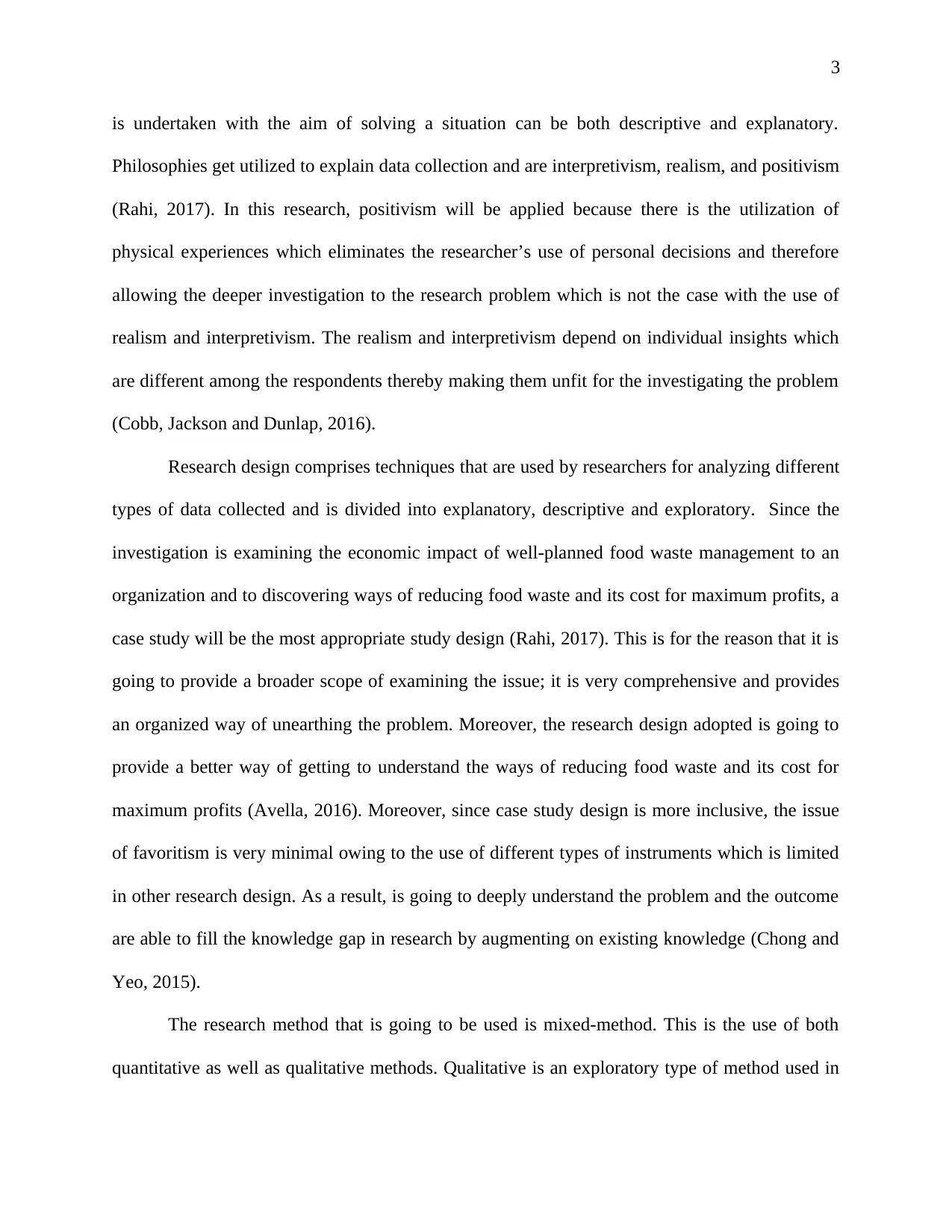
3
is undertaken with the aim of solving a situation can be both descriptive and explanatory.
Philosophies get utilized to explain data collection and are interpretivism, realism, and positivism
(Rahi, 2017). In this research, positivism will be applied because there is the utilization of
physical experiences which eliminates the researcher’s use of personal decisions and therefore
allowing the deeper investigation to the research problem which is not the case with the use of
realism and interpretivism. The realism and interpretivism depend on individual insights which
are different among the respondents thereby making them unfit for the investigating the problem
(Cobb, Jackson and Dunlap, 2016).
Research design comprises techniques that are used by researchers for analyzing different
types of data collected and is divided into explanatory, descriptive and exploratory. Since the
investigation is examining the economic impact of well-planned food waste management to an
organization and to discovering ways of reducing food waste and its cost for maximum profits, a
case study will be the most appropriate study design (Rahi, 2017). This is for the reason that it is
going to provide a broader scope of examining the issue; it is very comprehensive and provides
an organized way of unearthing the problem. Moreover, the research design adopted is going to
provide a better way of getting to understand the ways of reducing food waste and its cost for
maximum profits (Avella, 2016). Moreover, since case study design is more inclusive, the issue
of favoritism is very minimal owing to the use of different types of instruments which is limited
in other research design. As a result, is going to deeply understand the problem and the outcome
are able to fill the knowledge gap in research by augmenting on existing knowledge (Chong and
Yeo, 2015).
The research method that is going to be used is mixed-method. This is the use of both
quantitative as well as qualitative methods. Qualitative is an exploratory type of method used in
is undertaken with the aim of solving a situation can be both descriptive and explanatory.
Philosophies get utilized to explain data collection and are interpretivism, realism, and positivism
(Rahi, 2017). In this research, positivism will be applied because there is the utilization of
physical experiences which eliminates the researcher’s use of personal decisions and therefore
allowing the deeper investigation to the research problem which is not the case with the use of
realism and interpretivism. The realism and interpretivism depend on individual insights which
are different among the respondents thereby making them unfit for the investigating the problem
(Cobb, Jackson and Dunlap, 2016).
Research design comprises techniques that are used by researchers for analyzing different
types of data collected and is divided into explanatory, descriptive and exploratory. Since the
investigation is examining the economic impact of well-planned food waste management to an
organization and to discovering ways of reducing food waste and its cost for maximum profits, a
case study will be the most appropriate study design (Rahi, 2017). This is for the reason that it is
going to provide a broader scope of examining the issue; it is very comprehensive and provides
an organized way of unearthing the problem. Moreover, the research design adopted is going to
provide a better way of getting to understand the ways of reducing food waste and its cost for
maximum profits (Avella, 2016). Moreover, since case study design is more inclusive, the issue
of favoritism is very minimal owing to the use of different types of instruments which is limited
in other research design. As a result, is going to deeply understand the problem and the outcome
are able to fill the knowledge gap in research by augmenting on existing knowledge (Chong and
Yeo, 2015).
The research method that is going to be used is mixed-method. This is the use of both
quantitative as well as qualitative methods. Qualitative is an exploratory type of method used in
⊘ This is a preview!⊘
Do you want full access?
Subscribe today to unlock all pages.

Trusted by 1+ million students worldwide
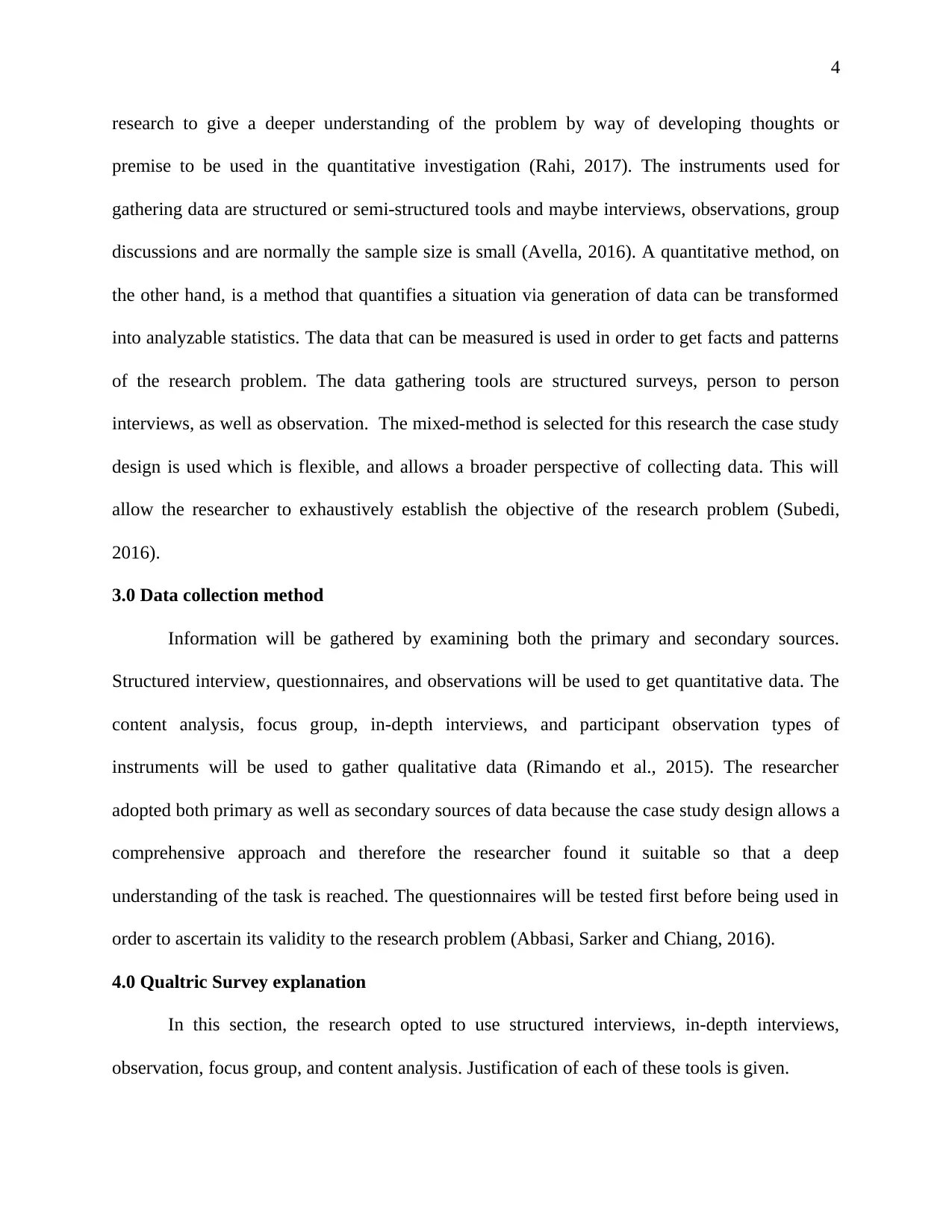
4
research to give a deeper understanding of the problem by way of developing thoughts or
premise to be used in the quantitative investigation (Rahi, 2017). The instruments used for
gathering data are structured or semi-structured tools and maybe interviews, observations, group
discussions and are normally the sample size is small (Avella, 2016). A quantitative method, on
the other hand, is a method that quantifies a situation via generation of data can be transformed
into analyzable statistics. The data that can be measured is used in order to get facts and patterns
of the research problem. The data gathering tools are structured surveys, person to person
interviews, as well as observation. The mixed-method is selected for this research the case study
design is used which is flexible, and allows a broader perspective of collecting data. This will
allow the researcher to exhaustively establish the objective of the research problem (Subedi,
2016).
3.0 Data collection method
Information will be gathered by examining both the primary and secondary sources.
Structured interview, questionnaires, and observations will be used to get quantitative data. The
content analysis, focus group, in-depth interviews, and participant observation types of
instruments will be used to gather qualitative data (Rimando et al., 2015). The researcher
adopted both primary as well as secondary sources of data because the case study design allows a
comprehensive approach and therefore the researcher found it suitable so that a deep
understanding of the task is reached. The questionnaires will be tested first before being used in
order to ascertain its validity to the research problem (Abbasi, Sarker and Chiang, 2016).
4.0 Qualtric Survey explanation
In this section, the research opted to use structured interviews, in-depth interviews,
observation, focus group, and content analysis. Justification of each of these tools is given.
research to give a deeper understanding of the problem by way of developing thoughts or
premise to be used in the quantitative investigation (Rahi, 2017). The instruments used for
gathering data are structured or semi-structured tools and maybe interviews, observations, group
discussions and are normally the sample size is small (Avella, 2016). A quantitative method, on
the other hand, is a method that quantifies a situation via generation of data can be transformed
into analyzable statistics. The data that can be measured is used in order to get facts and patterns
of the research problem. The data gathering tools are structured surveys, person to person
interviews, as well as observation. The mixed-method is selected for this research the case study
design is used which is flexible, and allows a broader perspective of collecting data. This will
allow the researcher to exhaustively establish the objective of the research problem (Subedi,
2016).
3.0 Data collection method
Information will be gathered by examining both the primary and secondary sources.
Structured interview, questionnaires, and observations will be used to get quantitative data. The
content analysis, focus group, in-depth interviews, and participant observation types of
instruments will be used to gather qualitative data (Rimando et al., 2015). The researcher
adopted both primary as well as secondary sources of data because the case study design allows a
comprehensive approach and therefore the researcher found it suitable so that a deep
understanding of the task is reached. The questionnaires will be tested first before being used in
order to ascertain its validity to the research problem (Abbasi, Sarker and Chiang, 2016).
4.0 Qualtric Survey explanation
In this section, the research opted to use structured interviews, in-depth interviews,
observation, focus group, and content analysis. Justification of each of these tools is given.
Paraphrase This Document
Need a fresh take? Get an instant paraphrase of this document with our AI Paraphraser

5
The Structured interview was selected because of its precise nature of information on an
interview and it is effective. However, the complexity of the question gives a limited scope
creates no rapport with resources persons and thus limiting the assessment (Rahi, 2017).
The in-depth interviews allow the resources persons to share information with no bias
and feedback if very high but less standardized which may lead to the interviewer being biased
and the tool is long and may not be consistent (Avella, 2016).
The Observation allows the researcher to make observation the way it is in a natural
setting thereby giving a deeper insight as compared to other methods. However, the tool is prone
to a high degree of bias because the opinion of the researcher may change and the analyzed
results (Rahi, 2017).
Focus groups, on the other hand, are very detailed thus providing a broad range of data
but it is shallow and does not give a deeper output of the situation (Avella, 2016).
Content analysis is used because it permits the researcher to make an analysis between
the section and connections of the case under investigation as well as allowing the analysis of the
coded content (Rahi, 2017).
5.0 Sample Selection
Both the probabilistic as well as non-probabilistic will be used in the research. The
investigator is adopting probability so that random sampling will be carried out in the selection
of elements of investigation; this is where all elements that are going to take part in the research
have the same chances of being selected. In the selection of the organization where the research
will be taken, the non-probabilistic method is employed; which gives the researcher discretion to
select an organization purposefully (Gentles, Charles, Ploeg and McKibbon, 2015).
The Structured interview was selected because of its precise nature of information on an
interview and it is effective. However, the complexity of the question gives a limited scope
creates no rapport with resources persons and thus limiting the assessment (Rahi, 2017).
The in-depth interviews allow the resources persons to share information with no bias
and feedback if very high but less standardized which may lead to the interviewer being biased
and the tool is long and may not be consistent (Avella, 2016).
The Observation allows the researcher to make observation the way it is in a natural
setting thereby giving a deeper insight as compared to other methods. However, the tool is prone
to a high degree of bias because the opinion of the researcher may change and the analyzed
results (Rahi, 2017).
Focus groups, on the other hand, are very detailed thus providing a broad range of data
but it is shallow and does not give a deeper output of the situation (Avella, 2016).
Content analysis is used because it permits the researcher to make an analysis between
the section and connections of the case under investigation as well as allowing the analysis of the
coded content (Rahi, 2017).
5.0 Sample Selection
Both the probabilistic as well as non-probabilistic will be used in the research. The
investigator is adopting probability so that random sampling will be carried out in the selection
of elements of investigation; this is where all elements that are going to take part in the research
have the same chances of being selected. In the selection of the organization where the research
will be taken, the non-probabilistic method is employed; which gives the researcher discretion to
select an organization purposefully (Gentles, Charles, Ploeg and McKibbon, 2015).
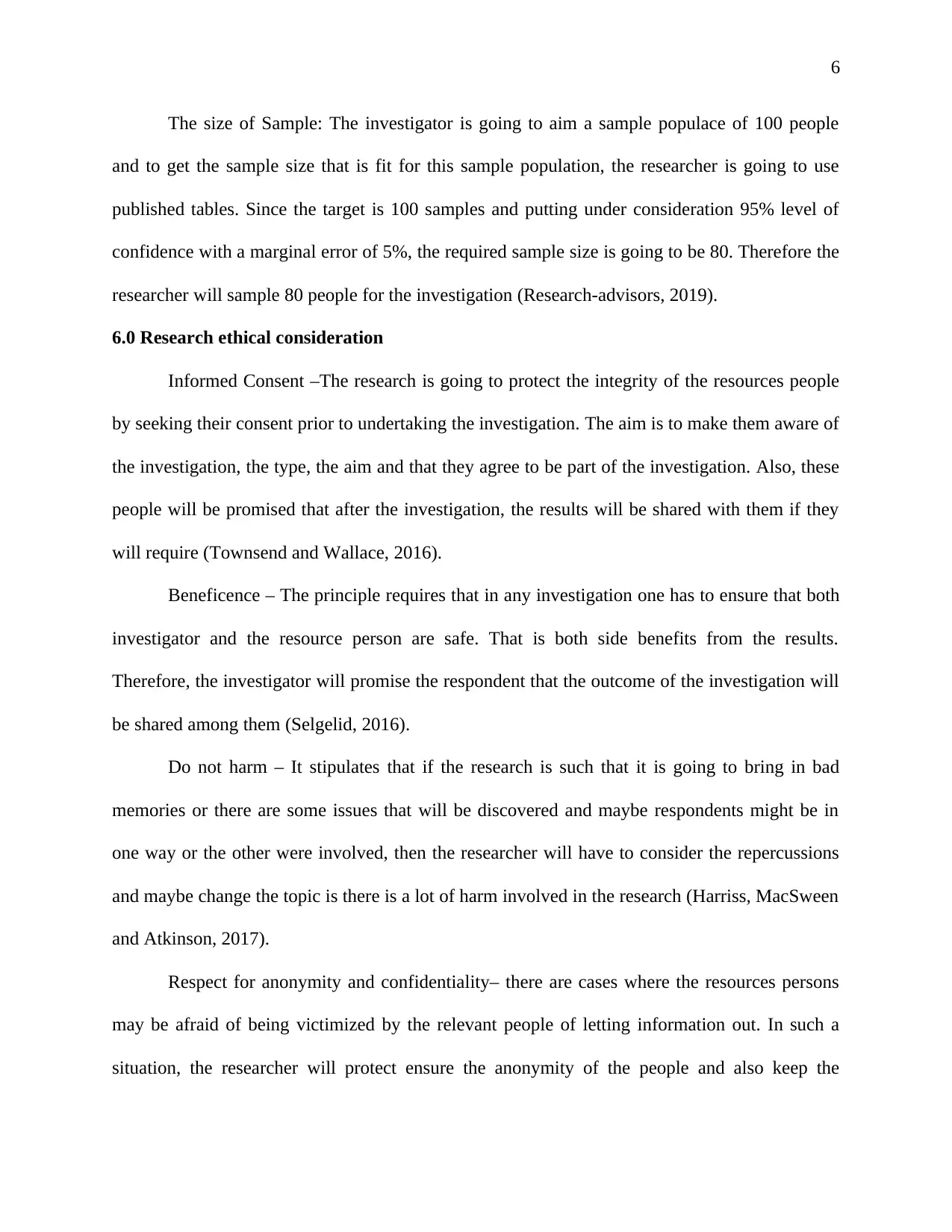
6
The size of Sample: The investigator is going to aim a sample populace of 100 people
and to get the sample size that is fit for this sample population, the researcher is going to use
published tables. Since the target is 100 samples and putting under consideration 95% level of
confidence with a marginal error of 5%, the required sample size is going to be 80. Therefore the
researcher will sample 80 people for the investigation (Research-advisors, 2019).
6.0 Research ethical consideration
Informed Consent –The research is going to protect the integrity of the resources people
by seeking their consent prior to undertaking the investigation. The aim is to make them aware of
the investigation, the type, the aim and that they agree to be part of the investigation. Also, these
people will be promised that after the investigation, the results will be shared with them if they
will require (Townsend and Wallace, 2016).
Beneficence – The principle requires that in any investigation one has to ensure that both
investigator and the resource person are safe. That is both side benefits from the results.
Therefore, the investigator will promise the respondent that the outcome of the investigation will
be shared among them (Selgelid, 2016).
Do not harm – It stipulates that if the research is such that it is going to bring in bad
memories or there are some issues that will be discovered and maybe respondents might be in
one way or the other were involved, then the researcher will have to consider the repercussions
and maybe change the topic is there is a lot of harm involved in the research (Harriss, MacSween
and Atkinson, 2017).
Respect for anonymity and confidentiality– there are cases where the resources persons
may be afraid of being victimized by the relevant people of letting information out. In such a
situation, the researcher will protect ensure the anonymity of the people and also keep the
The size of Sample: The investigator is going to aim a sample populace of 100 people
and to get the sample size that is fit for this sample population, the researcher is going to use
published tables. Since the target is 100 samples and putting under consideration 95% level of
confidence with a marginal error of 5%, the required sample size is going to be 80. Therefore the
researcher will sample 80 people for the investigation (Research-advisors, 2019).
6.0 Research ethical consideration
Informed Consent –The research is going to protect the integrity of the resources people
by seeking their consent prior to undertaking the investigation. The aim is to make them aware of
the investigation, the type, the aim and that they agree to be part of the investigation. Also, these
people will be promised that after the investigation, the results will be shared with them if they
will require (Townsend and Wallace, 2016).
Beneficence – The principle requires that in any investigation one has to ensure that both
investigator and the resource person are safe. That is both side benefits from the results.
Therefore, the investigator will promise the respondent that the outcome of the investigation will
be shared among them (Selgelid, 2016).
Do not harm – It stipulates that if the research is such that it is going to bring in bad
memories or there are some issues that will be discovered and maybe respondents might be in
one way or the other were involved, then the researcher will have to consider the repercussions
and maybe change the topic is there is a lot of harm involved in the research (Harriss, MacSween
and Atkinson, 2017).
Respect for anonymity and confidentiality– there are cases where the resources persons
may be afraid of being victimized by the relevant people of letting information out. In such a
situation, the researcher will protect ensure the anonymity of the people and also keep the
⊘ This is a preview!⊘
Do you want full access?
Subscribe today to unlock all pages.

Trusted by 1+ million students worldwide
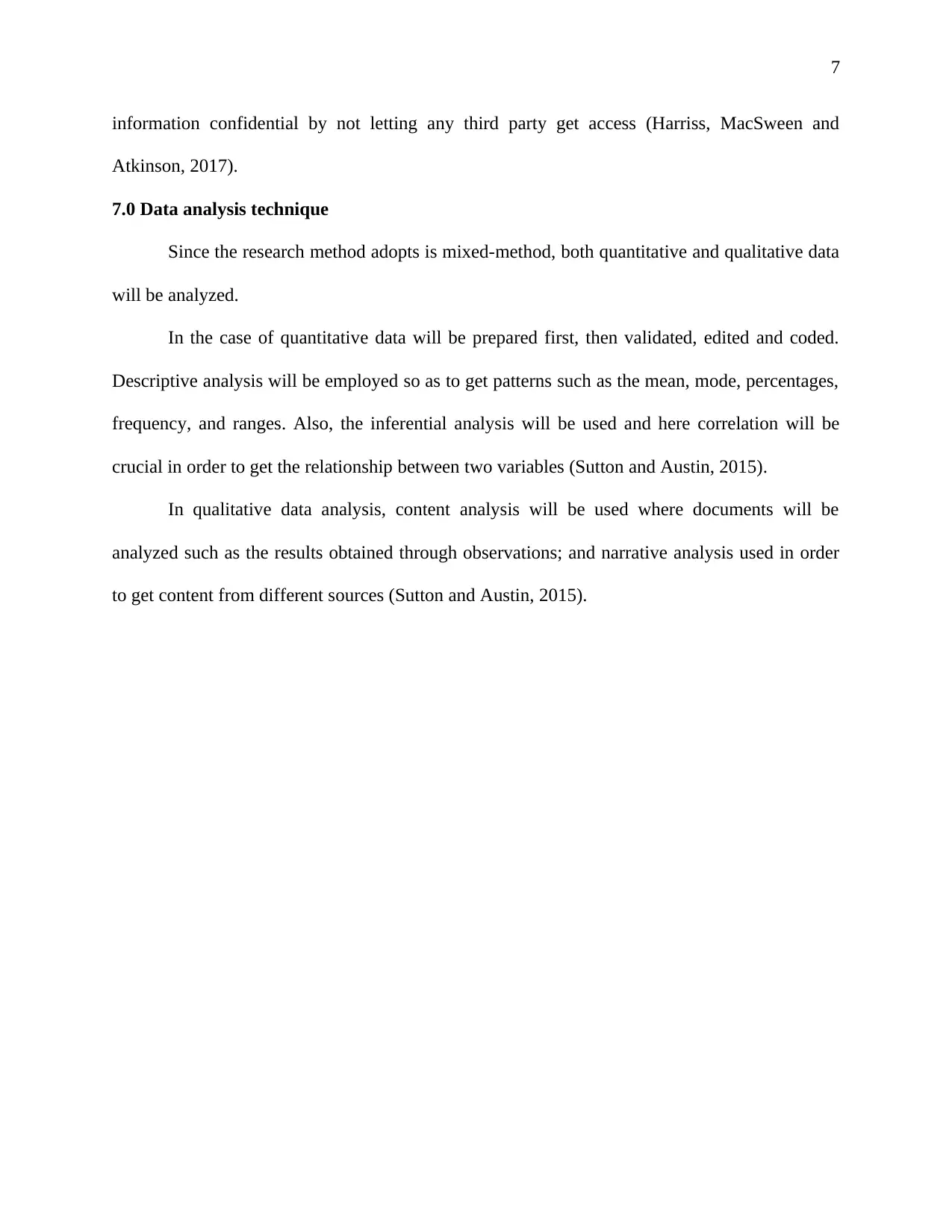
7
information confidential by not letting any third party get access (Harriss, MacSween and
Atkinson, 2017).
7.0 Data analysis technique
Since the research method adopts is mixed-method, both quantitative and qualitative data
will be analyzed.
In the case of quantitative data will be prepared first, then validated, edited and coded.
Descriptive analysis will be employed so as to get patterns such as the mean, mode, percentages,
frequency, and ranges. Also, the inferential analysis will be used and here correlation will be
crucial in order to get the relationship between two variables (Sutton and Austin, 2015).
In qualitative data analysis, content analysis will be used where documents will be
analyzed such as the results obtained through observations; and narrative analysis used in order
to get content from different sources (Sutton and Austin, 2015).
information confidential by not letting any third party get access (Harriss, MacSween and
Atkinson, 2017).
7.0 Data analysis technique
Since the research method adopts is mixed-method, both quantitative and qualitative data
will be analyzed.
In the case of quantitative data will be prepared first, then validated, edited and coded.
Descriptive analysis will be employed so as to get patterns such as the mean, mode, percentages,
frequency, and ranges. Also, the inferential analysis will be used and here correlation will be
crucial in order to get the relationship between two variables (Sutton and Austin, 2015).
In qualitative data analysis, content analysis will be used where documents will be
analyzed such as the results obtained through observations; and narrative analysis used in order
to get content from different sources (Sutton and Austin, 2015).
Paraphrase This Document
Need a fresh take? Get an instant paraphrase of this document with our AI Paraphraser
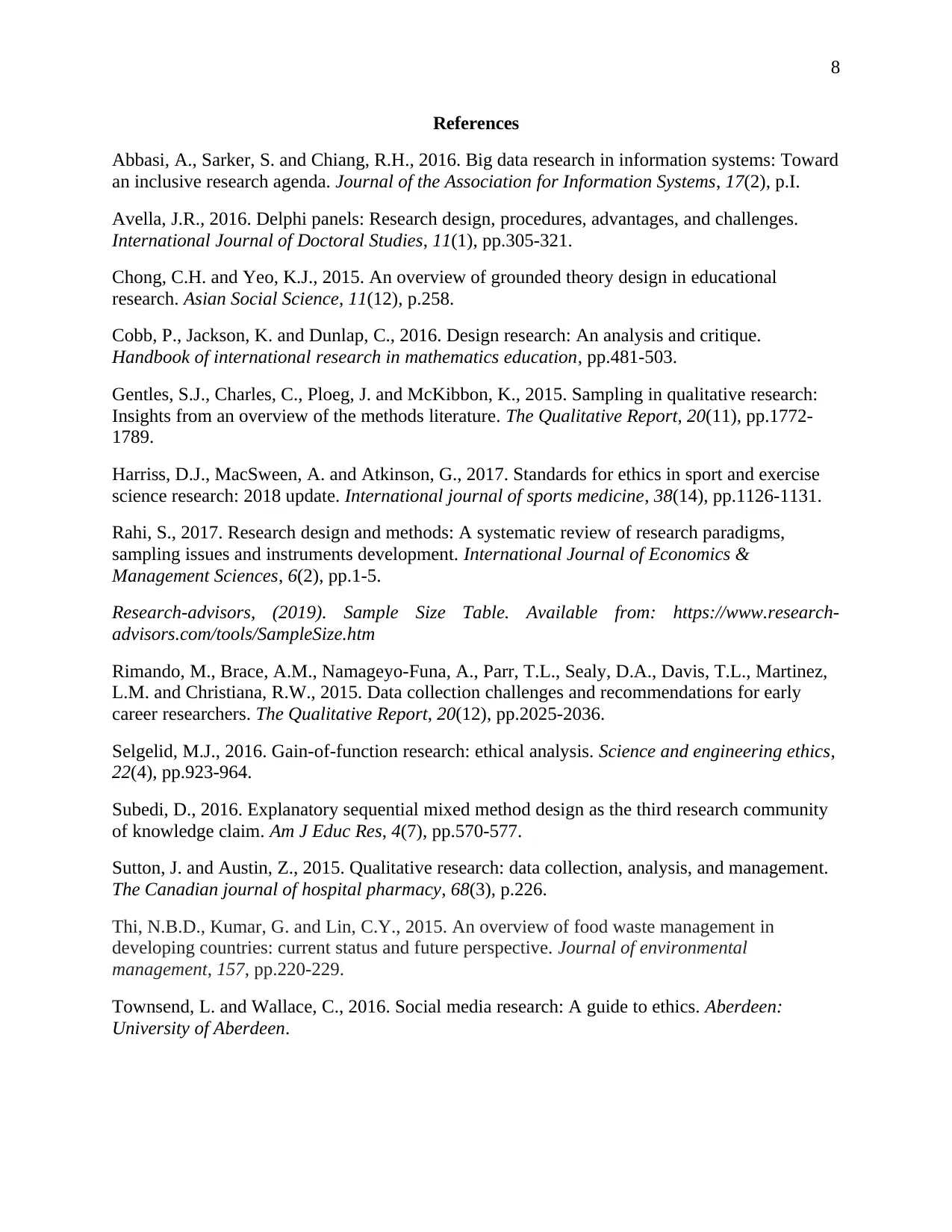
8
References
Abbasi, A., Sarker, S. and Chiang, R.H., 2016. Big data research in information systems: Toward
an inclusive research agenda. Journal of the Association for Information Systems, 17(2), p.I.
Avella, J.R., 2016. Delphi panels: Research design, procedures, advantages, and challenges.
International Journal of Doctoral Studies, 11(1), pp.305-321.
Chong, C.H. and Yeo, K.J., 2015. An overview of grounded theory design in educational
research. Asian Social Science, 11(12), p.258.
Cobb, P., Jackson, K. and Dunlap, C., 2016. Design research: An analysis and critique.
Handbook of international research in mathematics education, pp.481-503.
Gentles, S.J., Charles, C., Ploeg, J. and McKibbon, K., 2015. Sampling in qualitative research:
Insights from an overview of the methods literature. The Qualitative Report, 20(11), pp.1772-
1789.
Harriss, D.J., MacSween, A. and Atkinson, G., 2017. Standards for ethics in sport and exercise
science research: 2018 update. International journal of sports medicine, 38(14), pp.1126-1131.
Rahi, S., 2017. Research design and methods: A systematic review of research paradigms,
sampling issues and instruments development. International Journal of Economics &
Management Sciences, 6(2), pp.1-5.
Research-advisors, (2019). Sample Size Table. Available from: https://www.research-
advisors.com/tools/SampleSize.htm
Rimando, M., Brace, A.M., Namageyo-Funa, A., Parr, T.L., Sealy, D.A., Davis, T.L., Martinez,
L.M. and Christiana, R.W., 2015. Data collection challenges and recommendations for early
career researchers. The Qualitative Report, 20(12), pp.2025-2036.
Selgelid, M.J., 2016. Gain-of-function research: ethical analysis. Science and engineering ethics,
22(4), pp.923-964.
Subedi, D., 2016. Explanatory sequential mixed method design as the third research community
of knowledge claim. Am J Educ Res, 4(7), pp.570-577.
Sutton, J. and Austin, Z., 2015. Qualitative research: data collection, analysis, and management.
The Canadian journal of hospital pharmacy, 68(3), p.226.
Thi, N.B.D., Kumar, G. and Lin, C.Y., 2015. An overview of food waste management in
developing countries: current status and future perspective. Journal of environmental
management, 157, pp.220-229.
Townsend, L. and Wallace, C., 2016. Social media research: A guide to ethics. Aberdeen:
University of Aberdeen.
References
Abbasi, A., Sarker, S. and Chiang, R.H., 2016. Big data research in information systems: Toward
an inclusive research agenda. Journal of the Association for Information Systems, 17(2), p.I.
Avella, J.R., 2016. Delphi panels: Research design, procedures, advantages, and challenges.
International Journal of Doctoral Studies, 11(1), pp.305-321.
Chong, C.H. and Yeo, K.J., 2015. An overview of grounded theory design in educational
research. Asian Social Science, 11(12), p.258.
Cobb, P., Jackson, K. and Dunlap, C., 2016. Design research: An analysis and critique.
Handbook of international research in mathematics education, pp.481-503.
Gentles, S.J., Charles, C., Ploeg, J. and McKibbon, K., 2015. Sampling in qualitative research:
Insights from an overview of the methods literature. The Qualitative Report, 20(11), pp.1772-
1789.
Harriss, D.J., MacSween, A. and Atkinson, G., 2017. Standards for ethics in sport and exercise
science research: 2018 update. International journal of sports medicine, 38(14), pp.1126-1131.
Rahi, S., 2017. Research design and methods: A systematic review of research paradigms,
sampling issues and instruments development. International Journal of Economics &
Management Sciences, 6(2), pp.1-5.
Research-advisors, (2019). Sample Size Table. Available from: https://www.research-
advisors.com/tools/SampleSize.htm
Rimando, M., Brace, A.M., Namageyo-Funa, A., Parr, T.L., Sealy, D.A., Davis, T.L., Martinez,
L.M. and Christiana, R.W., 2015. Data collection challenges and recommendations for early
career researchers. The Qualitative Report, 20(12), pp.2025-2036.
Selgelid, M.J., 2016. Gain-of-function research: ethical analysis. Science and engineering ethics,
22(4), pp.923-964.
Subedi, D., 2016. Explanatory sequential mixed method design as the third research community
of knowledge claim. Am J Educ Res, 4(7), pp.570-577.
Sutton, J. and Austin, Z., 2015. Qualitative research: data collection, analysis, and management.
The Canadian journal of hospital pharmacy, 68(3), p.226.
Thi, N.B.D., Kumar, G. and Lin, C.Y., 2015. An overview of food waste management in
developing countries: current status and future perspective. Journal of environmental
management, 157, pp.220-229.
Townsend, L. and Wallace, C., 2016. Social media research: A guide to ethics. Aberdeen:
University of Aberdeen.
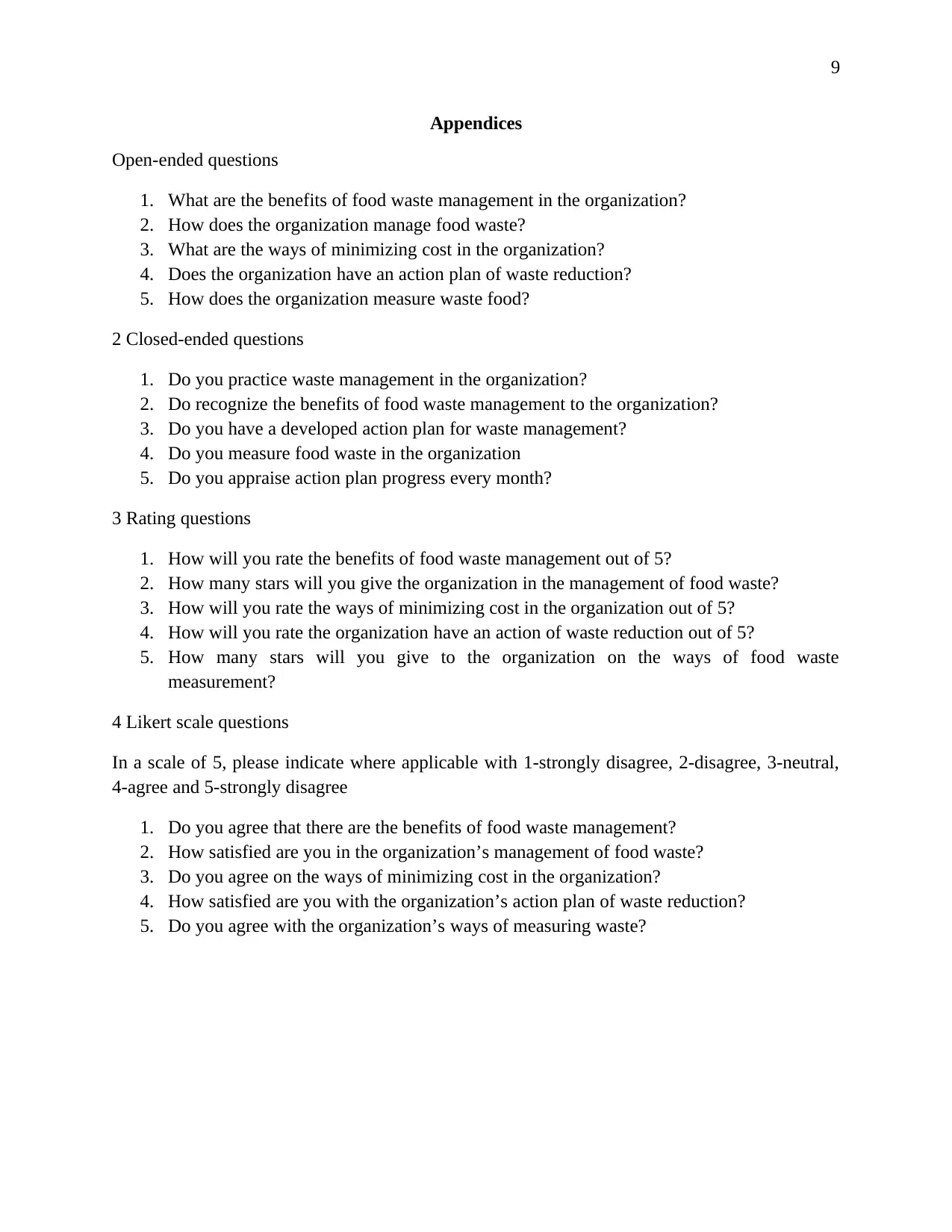
9
Appendices
Open-ended questions
1. What are the benefits of food waste management in the organization?
2. How does the organization manage food waste?
3. What are the ways of minimizing cost in the organization?
4. Does the organization have an action plan of waste reduction?
5. How does the organization measure waste food?
2 Closed-ended questions
1. Do you practice waste management in the organization?
2. Do recognize the benefits of food waste management to the organization?
3. Do you have a developed action plan for waste management?
4. Do you measure food waste in the organization
5. Do you appraise action plan progress every month?
3 Rating questions
1. How will you rate the benefits of food waste management out of 5?
2. How many stars will you give the organization in the management of food waste?
3. How will you rate the ways of minimizing cost in the organization out of 5?
4. How will you rate the organization have an action of waste reduction out of 5?
5. How many stars will you give to the organization on the ways of food waste
measurement?
4 Likert scale questions
In a scale of 5, please indicate where applicable with 1-strongly disagree, 2-disagree, 3-neutral,
4-agree and 5-strongly disagree
1. Do you agree that there are the benefits of food waste management?
2. How satisfied are you in the organization’s management of food waste?
3. Do you agree on the ways of minimizing cost in the organization?
4. How satisfied are you with the organization’s action plan of waste reduction?
5. Do you agree with the organization’s ways of measuring waste?
Appendices
Open-ended questions
1. What are the benefits of food waste management in the organization?
2. How does the organization manage food waste?
3. What are the ways of minimizing cost in the organization?
4. Does the organization have an action plan of waste reduction?
5. How does the organization measure waste food?
2 Closed-ended questions
1. Do you practice waste management in the organization?
2. Do recognize the benefits of food waste management to the organization?
3. Do you have a developed action plan for waste management?
4. Do you measure food waste in the organization
5. Do you appraise action plan progress every month?
3 Rating questions
1. How will you rate the benefits of food waste management out of 5?
2. How many stars will you give the organization in the management of food waste?
3. How will you rate the ways of minimizing cost in the organization out of 5?
4. How will you rate the organization have an action of waste reduction out of 5?
5. How many stars will you give to the organization on the ways of food waste
measurement?
4 Likert scale questions
In a scale of 5, please indicate where applicable with 1-strongly disagree, 2-disagree, 3-neutral,
4-agree and 5-strongly disagree
1. Do you agree that there are the benefits of food waste management?
2. How satisfied are you in the organization’s management of food waste?
3. Do you agree on the ways of minimizing cost in the organization?
4. How satisfied are you with the organization’s action plan of waste reduction?
5. Do you agree with the organization’s ways of measuring waste?
⊘ This is a preview!⊘
Do you want full access?
Subscribe today to unlock all pages.

Trusted by 1+ million students worldwide
1 out of 9
Related Documents
Your All-in-One AI-Powered Toolkit for Academic Success.
+13062052269
info@desklib.com
Available 24*7 on WhatsApp / Email
![[object Object]](/_next/static/media/star-bottom.7253800d.svg)
Unlock your academic potential
Copyright © 2020–2025 A2Z Services. All Rights Reserved. Developed and managed by ZUCOL.




